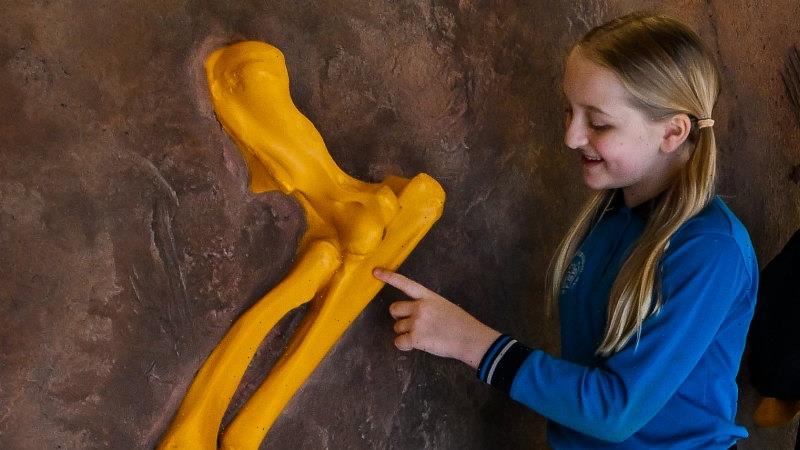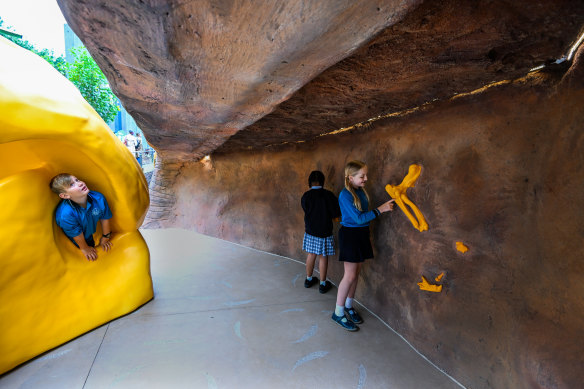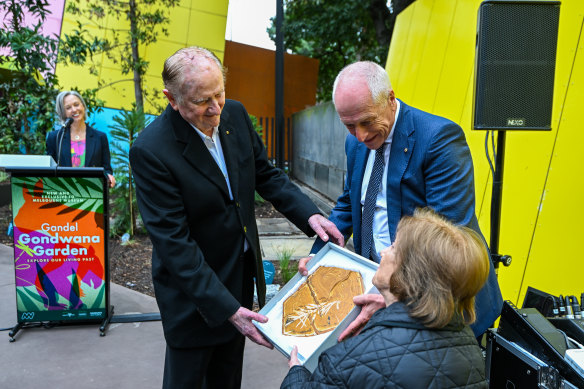Key points
- The $7 million Gandel Gondwana garden opens at Melbourne Museum on Friday.
- The paleontology themed garden is aimed at the six to 12 year olds who are too old for the Museum’s children’s gallery which caters for babies to age five.
- The ancient supercontinent Gondwana once connected most of the southern hemisphere, including Australia.
Melbourne Museum will attempt to harness the traditional tricky tween audience with its new paleontology-themed garden.
Officially opening on Friday, the $7 million Gandel Gondwana garden aims to capitalise on the success of the museum’s Triceratops fossil Horridus, which has attracted 800,000 visitors since it was unveiled last year.
School kids explore the Gandel Gondwana Garden at Melbourne Museum ahead of its opening on Friday. Credit:Joe Armao
The name for the garden comes from retail billionaires and philanthropists John and Pauline Gandel, who have funded the garden alongside the state government.
There are no actual dinosaur fossils on display in the 900 square metre outdoor space, only replicas, including a bright yellow giant-sized skull of the Thylacoleo, the largest marsupial predator that ever lived.
Instead, the focus is on Australia’s “living dinosaurs” with ancient plants like the Wollemi pine included in the garden and information combining First People’s knowledge with scientific research.
Museums Victoria chief executive Lynley Crosswell said the garden had transformed what was previously “a barren wasteland” within the museum’s grounds and would engage with a key age group for the museum by using QR codes and digital animations to bring the garden to life.
“We’re able to use technology to really engage today’s generation of digital natives through a series of enhancements,” Crosswell said. “We’re also creating the Drama in Gondwana experience, which is a digital quest, highly interactive exploration of this space for young people to extend their knowledge and understanding.”
Kate Phillips, senior curator of science exhibitions at Museums Victoria, said the tween age group was important for museums.
“The period of learning between six to 12 is so crucial in terms of developing interests that could last people for a lifetime,” she said. “If you stimulate and capture interests of kids in that age group, they have the potential to then go on and deepen that interest.”
Phillips said this could lead to a fantastic career or just a lifelong enjoyment and connection with the natural world and understanding of history.
John Gandel with wife Pauline Gandel and Leon Kempler of the Melbourne Museum Board. Credit:Joe Armao
Producer Anna Kilpatrick said the age group between six to 12 years was particularly diverse and presented unique challenges of engaging children who were only just learning to read to those who were older and more sophisticated.
“So if you’re at the younger end of that age group, you could experience the garden at face value, enjoy the plants, enjoy the colour, enjoy the garden,” she said.
“If you wanted to, you could dig a little bit deeper, so you could engage with the signs, go on this kind of explorative journey … and then if you wanted a little bit more information, you could use some of our digital guides to provide you with a deeper dive of content.”
Wandering through the garden, nine-year-old Lara Abo Hashema said she had learned how to pronounce the dinosaur names and read about how some dinosaurs hatched in eggs.
“There are so many interesting things to see and feel and touch and know about them,” she said.
Lara did have one criticism of the newly constructed garden: “The not-so-good parts are in some bits [where] the paint smells.”
A cultural guide to going out and loving your city. Sign up to our Culture Fix newsletter here.
Most Viewed in National
From our partners
Source: Read Full Article


